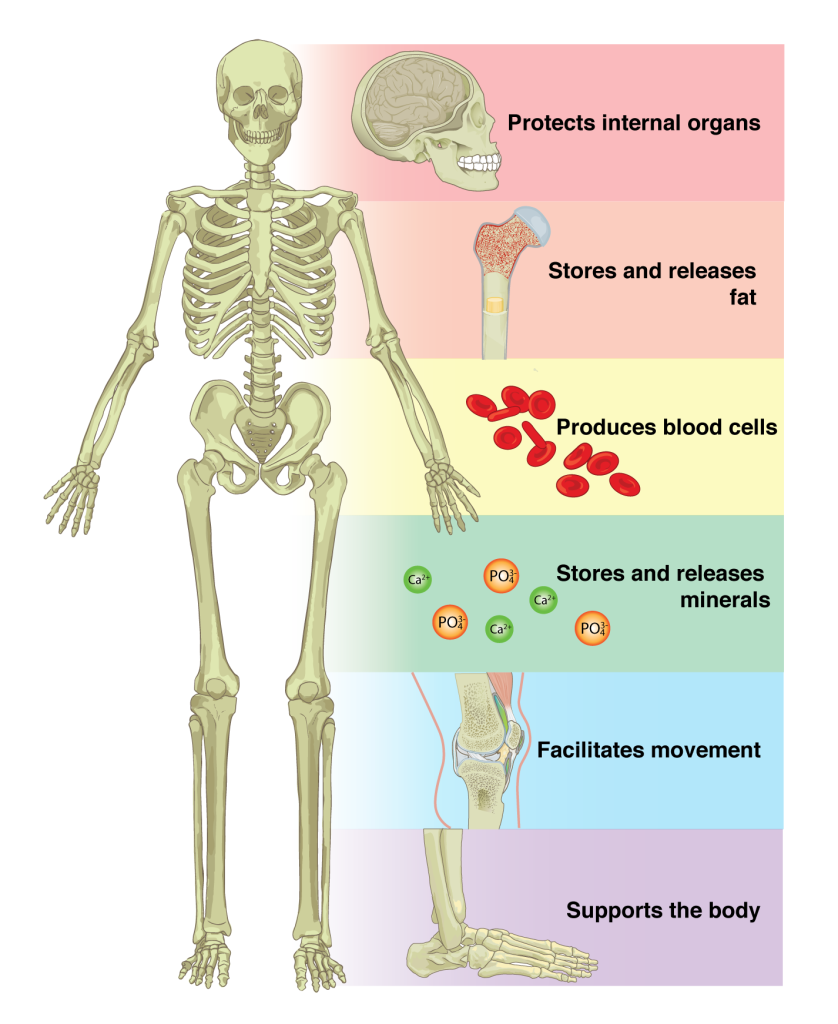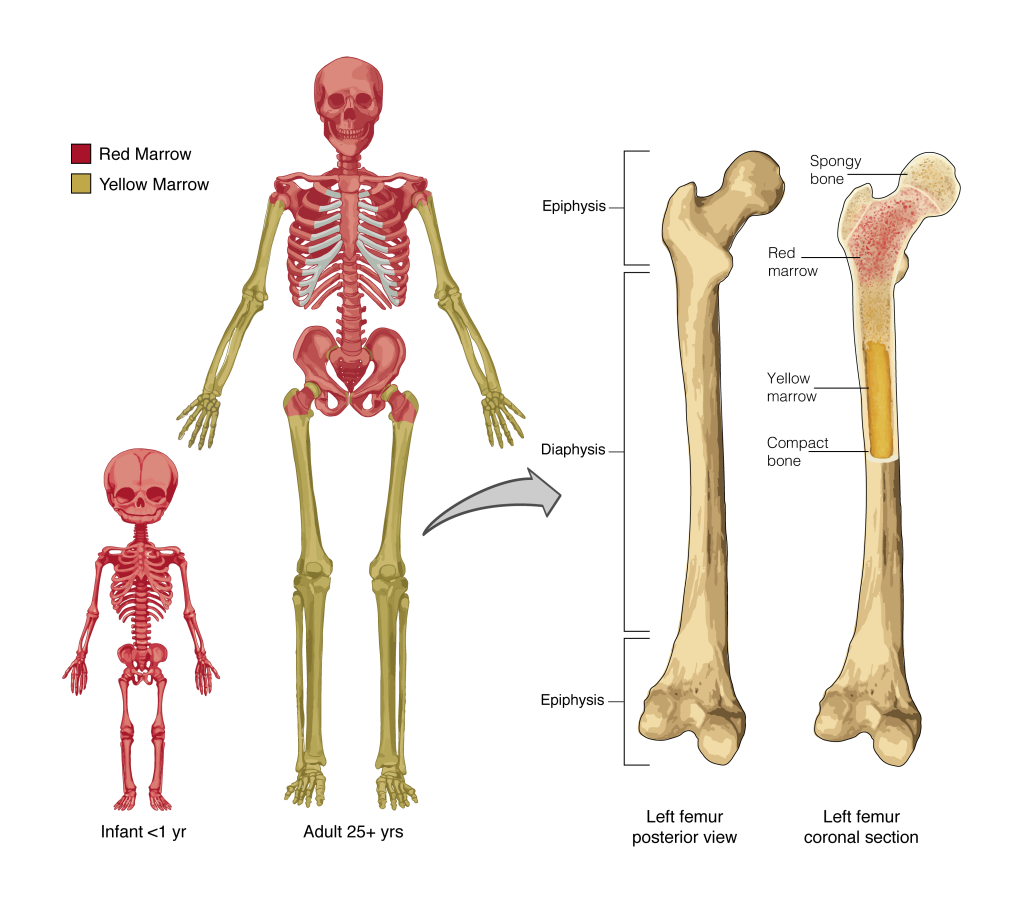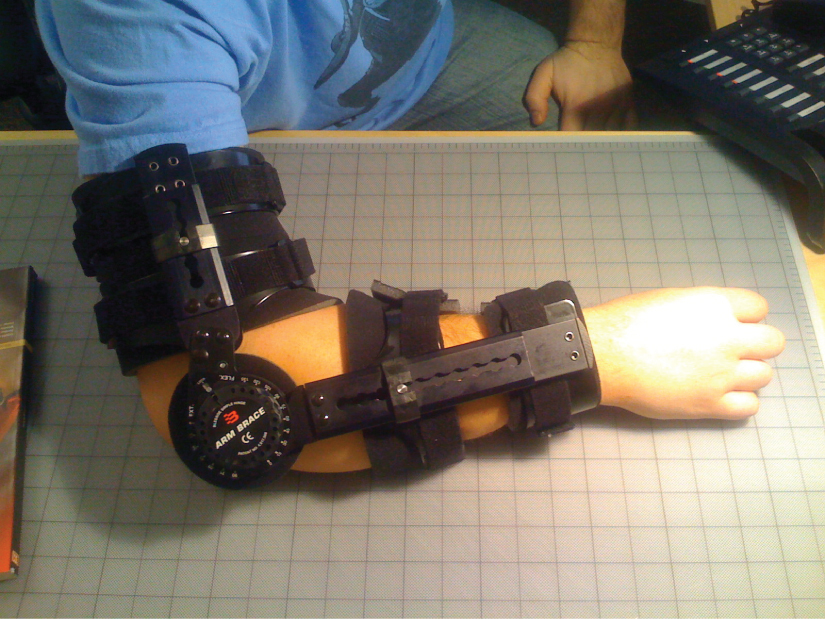Learning Objectives
By the end of this section, you will be able to:
List and describe the functions of the skeletal system
- Attribute specific functions of the skeletal system to specific components or structures
The skeletal system is the body system composed of bones, cartilages, ligaments and other tissues that perform essential functions for the human body. Bone tissue, or osseous tissue, is a hard, dense connective tissue that forms most of the adult skeleton, the internal support structure of the body. In the areas of the skeleton where whole bones move against each other (for example, joints like the shoulder or between the bones of the spine), cartilages, a semi-rigid form of connective tissue, provide flexibility and smooth surfaces for movement. Additionally, ligaments composed of dense connective tissue surround these joints, tying skeletal elements together (a ligament is the dense connective tissue that connect bones to other bones). Together, they perform the following functions:

Support, Movement, and Protection
Some functions of the skeletal system are more readily observable than others. When you move you can feel how your bones support you, facilitate your movement, and protect the soft organs of your body. Just as the steel beams of a building provide a scaffold to support its weight, the bones and cartilages of your skeletal system compose the scaffold that supports the rest of your body. Without the skeletal system, you would be a limp mass of organs, muscle, and skin. Bones facilitate movement by serving as points of attachment for your muscles. Bones also protect internal organs from injury by covering or surrounding them. For example, your ribs protect your lungs and heart, the bones of your vertebral column (spine) protect your spinal cord, and the bones of your cranium (skull) protect your brain (see Figure 6.1.1).
Mineral and Fat Storage, Blood Cell Formation
On a metabolic level, bone tissue performs several critical functions. For one, the bone tissue acts as a reservoir for a number of minerals important to the functioning of the body, especially calcium, and phosphorus. These minerals, incorporated into bone tissue, can be released back into the bloodstream to maintain levels needed to support physiological processes. Calcium ions, for example, are essential for muscle contractions and are involved in the transmission of nerve impulses.
Bones also serve as a site for fat storage and blood cell production. The unique connective tissue that fills the interior of most bones is referred to as bone marrow. There are two types of bone marrow: yellow bone marrow and red bone marrow. Yellow bone marrow contains adipose tissue, and the triglycerides stored in the adipocytes of this tissue can be released to serve as a source of energy for other tissues of the body. Red bone marrow is where the production of blood cells (named hematopoiesis, hemato- = “blood”, -poiesis = “to make”) takes place. Red blood cells, white blood cells, and platelets are all produced in the red bone marrow. As we age, the distribution of red and yellow bone marrow changes as seen in the figure (Figure 6.1.2).

Career Connection – Orthopedist
An orthopedist is a doctor who specializes in diagnosing and treating disorders and injuries related to the musculoskeletal system. Some orthopedic problems can be treated with medications, exercises, braces, and other devices, but others may be best treated with surgery (Figure 6.1.3).

While the origin of the word “orthopedics” (ortho- = “straight”; paed- = “child”), literally means “straightening of the child,” orthopedists can have patients who range from pediatric to geriatric. In recent years, orthopedists have even performed prenatal surgery to correct spina bifida, a congenital defect in which the neural canal in the spine of the fetus fails to close completely during embryologic development.
Orthopedists commonly treat bone and joint injuries but they also treat other bone conditions including curvature of the spine. Lateral curvatures (scoliosis) can be severe enough to slip under the shoulder blade (scapula) forcing it up as a hump. Spinal curvatures can also be excessive dorsoventrally (kyphosis) causing a hunch back and thoracic compression. These curvatures often appear in preteens as the result of poor posture, abnormal growth, or indeterminate causes. Mostly, they are readily treated by orthopedists. As people age, accumulated spinal column injuries and diseases like osteoporosis can also lead to curvatures of the spine, hence the stooping you sometimes see in the elderly.
Some orthopedists sub-specialize in sports medicine, which addresses both simple injuries, such as a sprained ankle, and complex injuries, such as a torn rotator cuff in the shoulder. Treatment can range from exercise to surgery.
Section Review
The major functions of the skeletal system are body support, facilitation of movement, protection of internal organs, storage of minerals and fat, and blood cell formation.
Review Questions
Critical Thinking Questions
- Suppose your red bone marrow could not be formed. What functions would your body not be able to perform?
- Suppose your osseous tissue could not store calcium. What functions would your body not be able to perform?
Glossary
- bone (osseous) tissue
- hard, dense connective tissue that forms the structural elements of the skeleton
- cartilage
- semi-rigid connective tissue found on the skeleton in areas where flexibility and smooth surfaces support movement
- hematopoiesis
- production of blood cells, which occurs in the red marrow of the bones
- ligament
- a dense connective tissue that connect one whole bone to another whole bone
- orthopedist
- doctor who specializes in diagnosing and treating musculoskeletal disorders and injuries
- red bone marrow
- connective tissue in the interior cavity of a bone where blood cell formation (hematopoiesis) takes place
- skeletal system
- organ system composed of bones, cartilage and ligaments that provides for movement, support, protection, mineral and fat storage, blood cells formation
- yellow bone marrow
- connective tissue in the interior cavity of a bone where fat is stored
Solutions
Answers for Critical Thinking Questions
- Without red bone marrow, you would not be able to produce blood cells. The red bone marrow is responsible for forming red and white blood cells as well as platelets. Red blood cells transport oxygen to tissues, and remove carbon dioxide. Without red blood cells, your tissues would not be able to produce ATP using oxygen. White blood cells play a role in the immune system fighting off foreign invaders in our body – without white blood cells you would not be able to recover from infection. Platelets are responsible for clotting your blood when a vessel ruptures. Without platelets you would bleed to death and die.
- The calcium in osseous tissue provides mineral support to bones. Without this calcium, the bones are not rigid and cannot be supportive. The calcium in osseous tissue is also an important storage site, that can release calcium when needed. Other organ systems rely on this calcium for action (specifically, muscle contraction and neural signaling). Without calcium storage, blood calcium levels change dramatically and affect muscle contraction and neural signaling.
This work, Anatomy & Physiology, is adapted from Anatomy & Physiology by OpenStax, licensed under CC BY. This edition, with revised content and artwork, is licensed under CC BY-SA except where otherwise noted.
Images, from Anatomy & Physiology by OpenStax, are licensed under CC BY except where otherwise noted.
Access the original for free at https://openstax.org/books/anatomy-and-physiology/pages/1-introduction.

